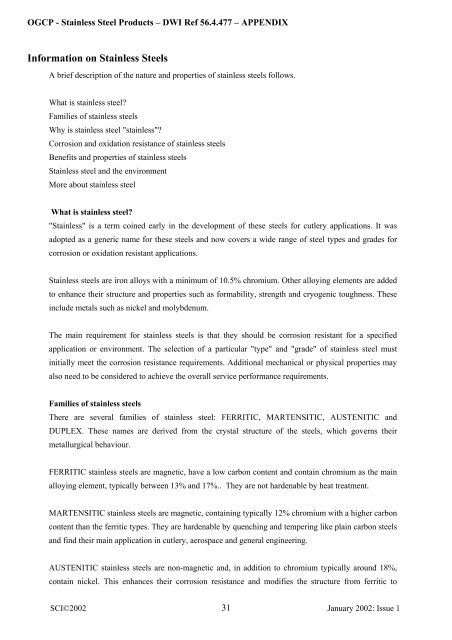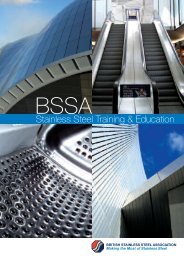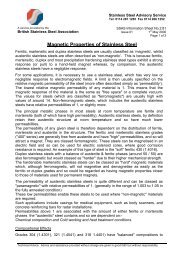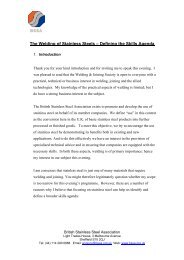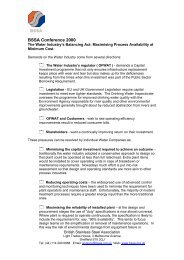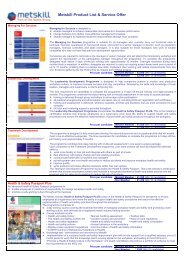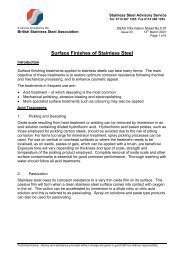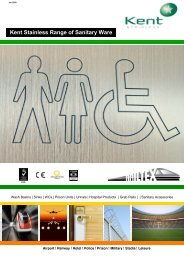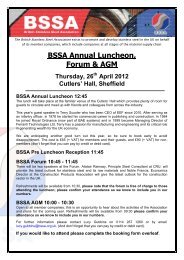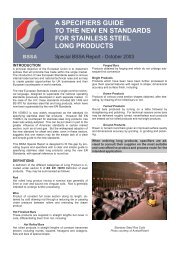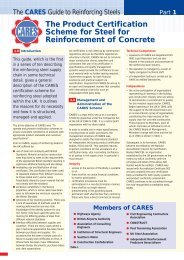Operational guidelines and code of practice for stainless steel
Operational guidelines and code of practice for stainless steel
Operational guidelines and code of practice for stainless steel
Create successful ePaper yourself
Turn your PDF publications into a flip-book with our unique Google optimized e-Paper software.
OGCP - Stainless Steel Products – DWI Ref 56.4.477 – APPENDIX<br />
In<strong>for</strong>mation on Stainless Steels<br />
A brief description <strong>of</strong> the nature <strong>and</strong> properties <strong>of</strong> <strong>stainless</strong> <strong>steel</strong>s follows.<br />
What is <strong>stainless</strong> <strong>steel</strong>?<br />
Families <strong>of</strong> <strong>stainless</strong> <strong>steel</strong>s<br />
Why is <strong>stainless</strong> <strong>steel</strong> "<strong>stainless</strong>"?<br />
Corrosion <strong>and</strong> oxidation resistance <strong>of</strong> <strong>stainless</strong> <strong>steel</strong>s<br />
Benefits <strong>and</strong> properties <strong>of</strong> <strong>stainless</strong> <strong>steel</strong>s<br />
Stainless <strong>steel</strong> <strong>and</strong> the environment<br />
More about <strong>stainless</strong> <strong>steel</strong><br />
What is <strong>stainless</strong> <strong>steel</strong>?<br />
"Stainless" is a term coined early in the development <strong>of</strong> these <strong>steel</strong>s <strong>for</strong> cutlery applications. It was<br />
adopted as a generic name <strong>for</strong> these <strong>steel</strong>s <strong>and</strong> now covers a wide range <strong>of</strong> <strong>steel</strong> types <strong>and</strong> grades <strong>for</strong><br />
corrosion or oxidation resistant applications.<br />
Stainless <strong>steel</strong>s are iron alloys with a minimum <strong>of</strong> 10.5% chromium. Other alloying elements are added<br />
to enhance their structure <strong>and</strong> properties such as <strong>for</strong>mability, strength <strong>and</strong> cryogenic toughness. These<br />
include metals such as nickel <strong>and</strong> molybdenum.<br />
The main requirement <strong>for</strong> <strong>stainless</strong> <strong>steel</strong>s is that they should be corrosion resistant <strong>for</strong> a specified<br />
application or environment. The selection <strong>of</strong> a particular "type" <strong>and</strong> "grade" <strong>of</strong> <strong>stainless</strong> <strong>steel</strong> must<br />
initially meet the corrosion resistance requirements. Additional mechanical or physical properties may<br />
also need to be considered to achieve the overall service per<strong>for</strong>mance requirements.<br />
Families <strong>of</strong> <strong>stainless</strong> <strong>steel</strong>s<br />
There are several families <strong>of</strong> <strong>stainless</strong> <strong>steel</strong>: FERRITIC, MARTENSITIC, AUSTENITIC <strong>and</strong><br />
DUPLEX. These names are derived from the crystal structure <strong>of</strong> the <strong>steel</strong>s, which governs their<br />
metallurgical behaviour.<br />
FERRITIC <strong>stainless</strong> <strong>steel</strong>s are magnetic, have a low carbon content <strong>and</strong> contain chromium as the main<br />
alloying element, typically between 13% <strong>and</strong> 17%.. They are not hardenable by heat treatment.<br />
MARTENSITIC <strong>stainless</strong> <strong>steel</strong>s are magnetic, containing typically 12% chromium with a higher carbon<br />
content than the ferritic types. They are hardenable by quenching <strong>and</strong> tempering like plain carbon <strong>steel</strong>s<br />
<strong>and</strong> find their main application in cutlery, aerospace <strong>and</strong> general engineering.<br />
AUSTENITIC <strong>stainless</strong> <strong>steel</strong>s are non-magnetic <strong>and</strong>, in addition to chromium typically around 18%,<br />
contain nickel. This enhances their corrosion resistance <strong>and</strong> modifies the structure from ferritic to<br />
SCI©2002 31<br />
January 2002: Issue 1


